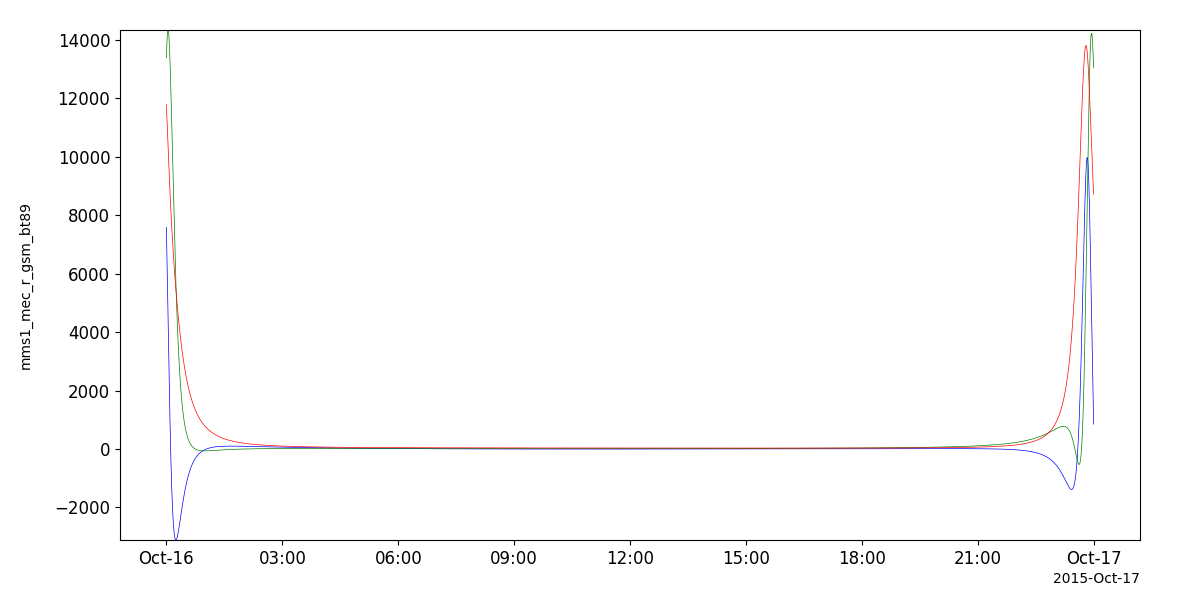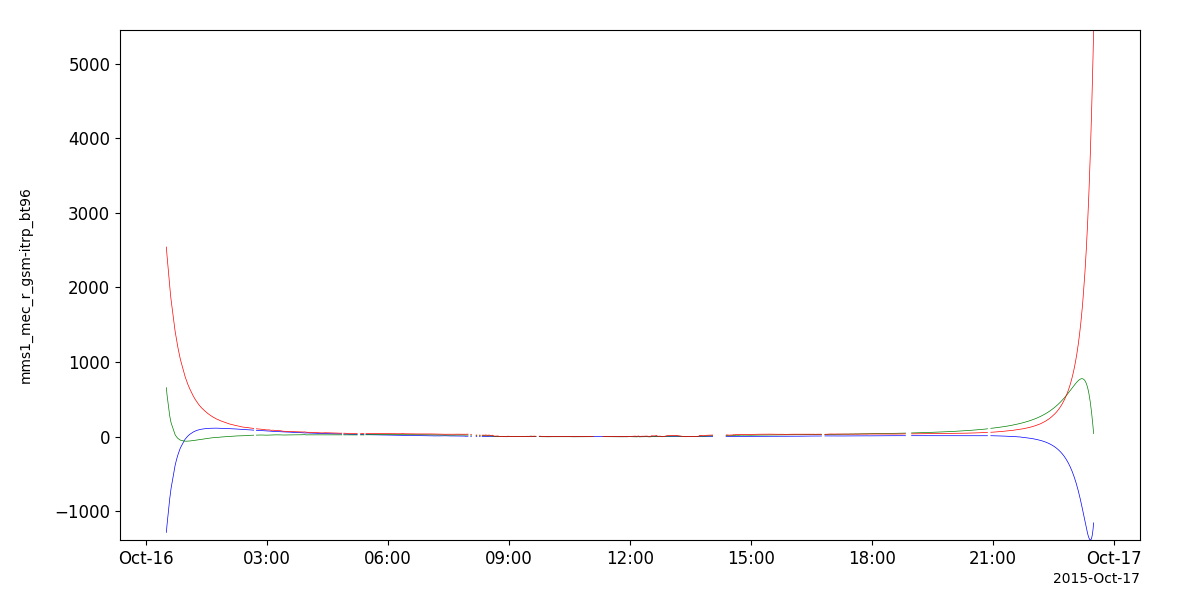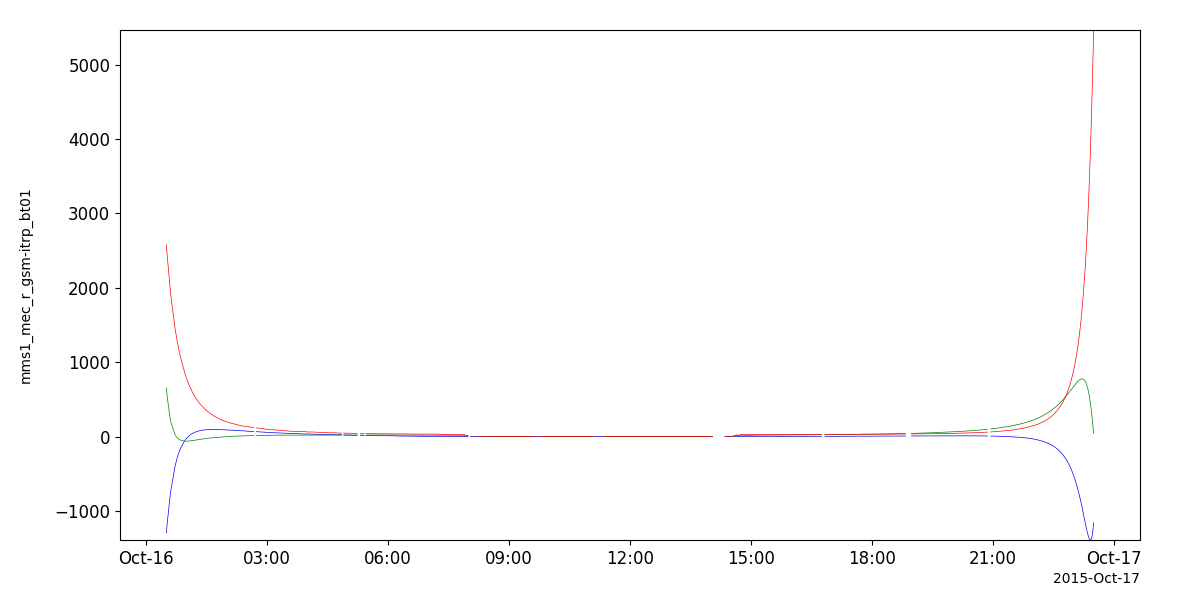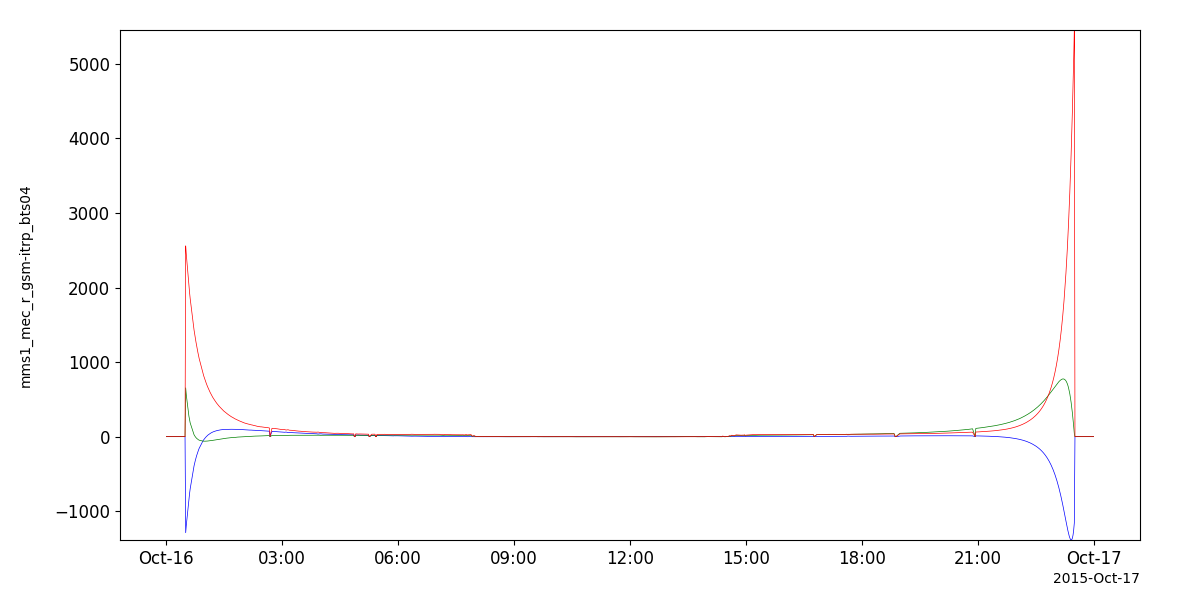Magnetic Field Models
The routines in this module can be used to calculate Tsyganenko magnetic field models using Sheng Tian’s implementation of the geopack library (https://github.com/tsssss/geopack).
Tsyganenko 89 (T89)
- pyspedas.geopack.tt89(pos_var_gsm, iopt=3, suffix='', igrf_only=False)
tplot wrapper for the functional interface to Sheng Tian’s implementation of the Tsyganenko 96 and IGRF model:
https://github.com/tsssss/geopack
- pos_gsm_tvar: str
tplot variable containing the position data (km) in GSM coordinates
T89 Example
# load some spacecraft position data
import pyspedas
pyspedas.mms.mec(trange=['2015-10-16', '2015-10-17'])
# calculate the field using the T89 model
from pyspedas.geopack import tt89
tt89('mms1_mec_r_gsm')
from pytplot import tplot
tplot('mms1_mec_r_gsm_bt89')

Tsyganenko 96 (T96)
- pyspedas.geopack.tt96(pos_var_gsm, parmod=None, suffix='')
tplot wrapper for the functional interface to Sheng Tian’s implementation of the Tsyganenko 96 and IGRF model:
https://github.com/tsssss/geopack
- pos_gsm_tvar: str
tplot variable containing the position data (km) in GSM coordinates
- Parameters
parmod (
ndarray) –- 10-element array (vs. time), but only the first 4 elements are used
solar wind pressure pdyn (nanopascals)
dst (nanotesla)
byimf (nanotesla)
bzimf (nanotesla)
suffix (
str) – Suffix to append to the tplot output variable
- Return type
Nameofthe tplot variable containing the model data
T96 Example
# load some spacecraft position data
import pyspedas
pyspedas.mms.mec(trange=['2015-10-16', '2015-10-17'])
# calculate the params using the solar wind data; see the "Solar Wind Parameters" section below for an example
# interpolate the MEC timestamps to the solar wind timestamps
from pyspedas import tinterpol
tinterpol('mms1_mec_r_gsm', 'proton_density')
# calculate the field using the T96 model
from pyspedas.geopack import tt96
tt96('mms1_mec_r_gsm-itrp', parmod=params)
from pytplot import tplot
tplot('mms1_mec_r_gsm-itrp_bt96')

Tsyganenko 2001 (T01)
- pyspedas.geopack.tt01(pos_var_gsm, parmod=None, suffix='')
tplot wrapper for the functional interface to Sheng Tian’s implementation of the Tsyganenko 2001 and IGRF model:
https://github.com/tsssss/geopack
- pos_gsm_tvar: str
tplot variable containing the position data (km) in GSM coordinates
- Parameters
parmod (
ndarray) –- 10-element array (vs. time), but only the first 6 elements are used
solar wind pressure pdyn (nanopascals),
dst (nanotesla)
byimf (nanotesla)
bzimf (nanotesla)
g1-index
g2-index (see Tsyganenko [2001] for an exact definition of these two indices)
suffix (
str) – Suffix to append to the tplot output variable
- Return type
Nameofthe tplot variable containing the model data
T01 Example
# load some spacecraft position data
import pyspedas
pyspedas.mms.mec(trange=['2015-10-16', '2015-10-17'])
# calculate the params using the solar wind data; see the "Solar Wind Parameters" section below for an example
# interpolate the MEC timestamps to the solar wind timestamps
from pyspedas import tinterpol
tinterpol('mms1_mec_r_gsm', 'proton_density')
# calculate the field using the T01 model
from pyspedas.geopack import tt01
tt01('mms1_mec_r_gsm-itrp', parmod=params)
from pytplot import tplot
tplot('mms1_mec_r_gsm-itrp_bt01')

Tsyganenko-Sitnov 2004 (TS04)
- pyspedas.geopack.tts04(pos_var_gsm, parmod=None, suffix='')
tplot wrapper for the functional interface to Sheng Tian’s implementation of the Tsyganenko-Sitnov (2004) storm-time geomagnetic field model
https://github.com/tsssss/geopack
- pos_gsm_tvar: str
tplot variable containing the position data (km) in GSM coordinates
- Parameters
parmod (
ndarray) –- 10-element array (vs. time):
solar wind pressure pdyn (nanopascals),
dst (nanotesla),
byimf,
(4) bzimf (nanotesla) (5-10) indices w1 - w6, calculated as time integrals from the beginning of a storm
see the reference (3) below, for a detailed definition of those variables
suffix (
str) – Suffix to append to the tplot output variable
- Return type
Nameofthe tplot variable containing the model data
TS04 Example
# load some spacecraft position data
import pyspedas
pyspedas.mms.mec(trange=['2015-10-16', '2015-10-17'])
# calculate the params using the solar wind data; see the "Solar Wind Parameters" section below for an example
# interpolate the MEC timestamps to the solar wind timestamps
from pyspedas import tinterpol
tinterpol('mms1_mec_r_gsm', 'proton_density')
# calculate the field using the TS04 model
from pyspedas.geopack import tts04
tts04('mms1_mec_r_gsm-itrp', parmod=params)
from pytplot import tplot
tplot('mms1_mec_r_gsm-itrp_bts04')

Solar Wind Parameters
To generate the “parmod” variable using Dst and solar wind data, use the get_tsy_params routine.
- pyspedas.geopack.get_tsy_params.get_tsy_params(dst_tvar, imf_tvar, Np_tvar, Vp_tvar, model, pressure_tvar=None, newname=None, speed=False, g_variables=None)
This procedure will interpolate inputs, generate Tsyganenko model parameters and store them in a tplot variable that can be passed directly to the model procedure.
- dst_tvar: str
tplot variable containing the Dst index
- imf_tvar: str
tplot variable containing the interplanetary magnetic field vector in GSM coordinates
- Np_tvar: str
tplot variable containing the solar wind ion density (cm**-3)
- Vp_tvar: str
tplot variable containing the proton velocity
- model: str
Tsyganenko model; should be: ‘T89’, T96’, ‘T01’,’TS04’
- Parameters
newname (
str) – name of the output variable; default: t96_par, ‘t01_par’ or ‘ts04_par’, depending on the modelspeed (
bool) – Flag to indicate Vp_tvar is speed, and not velocity (defaults to False)pressure_tvar (
str) – Set this to specify a tplot variable containing solar wind dynamic pressure data. If not supplied, it will be calculated internally from proton density and proton speed.
- Returns
Nameofthe tplot variable containing the parameters.The parameters are–solar wind pressure pdyn (nanopascals),
dst (nanotesla),
byimf,
(4) bzimf (nanotesla) (5-10) indices w1 - w6, calculated as time integrals from the beginning of a storm
see the reference (3) below, for a detailed definition of those variables
get_tsy_params Example
# load Dst and solar wind data
import pyspedas
pyspedas.kyoto.dst(trange=['2015-10-16', '2015-10-17'])
pyspedas.omni.data(trange=['2015-10-16', '2015-10-17'])
# join the components of B into a single variable
# BX isn't used
from pytplot import join_vec
join_vec(['BX_GSE', 'BY_GSM', 'BZ_GSM'])
from pyspedas.geopack.get_tsy_params import get_tsy_params
params = get_tsy_params('kyoto_dst',
'BX_GSE-BY_GSM-BZ_GSM_joined',
'proton_density',
'flow_speed',
't96', # or 't01', 'ts04'
pressure_tvar='Pressure',
speed=True)